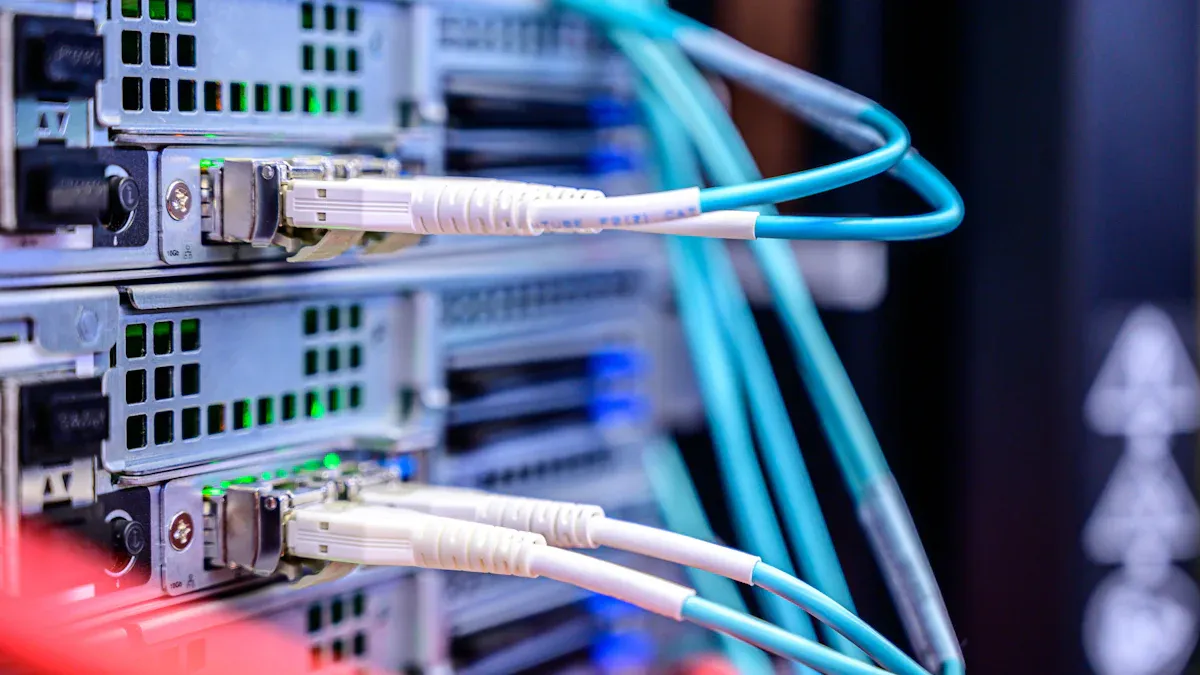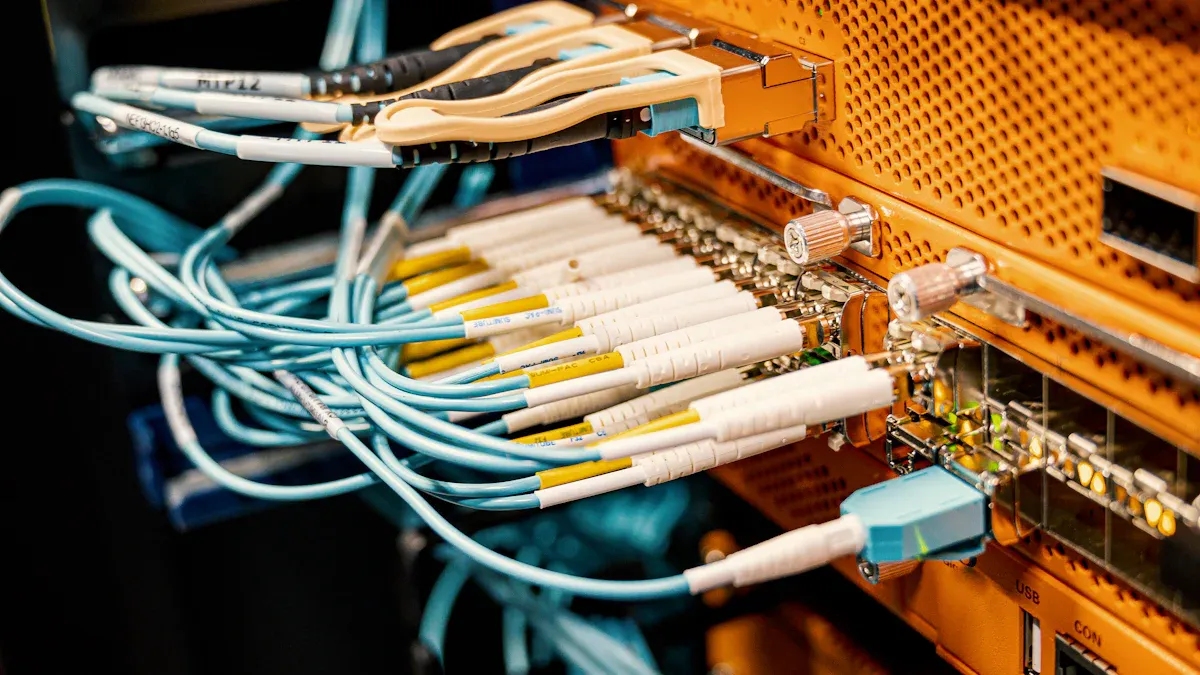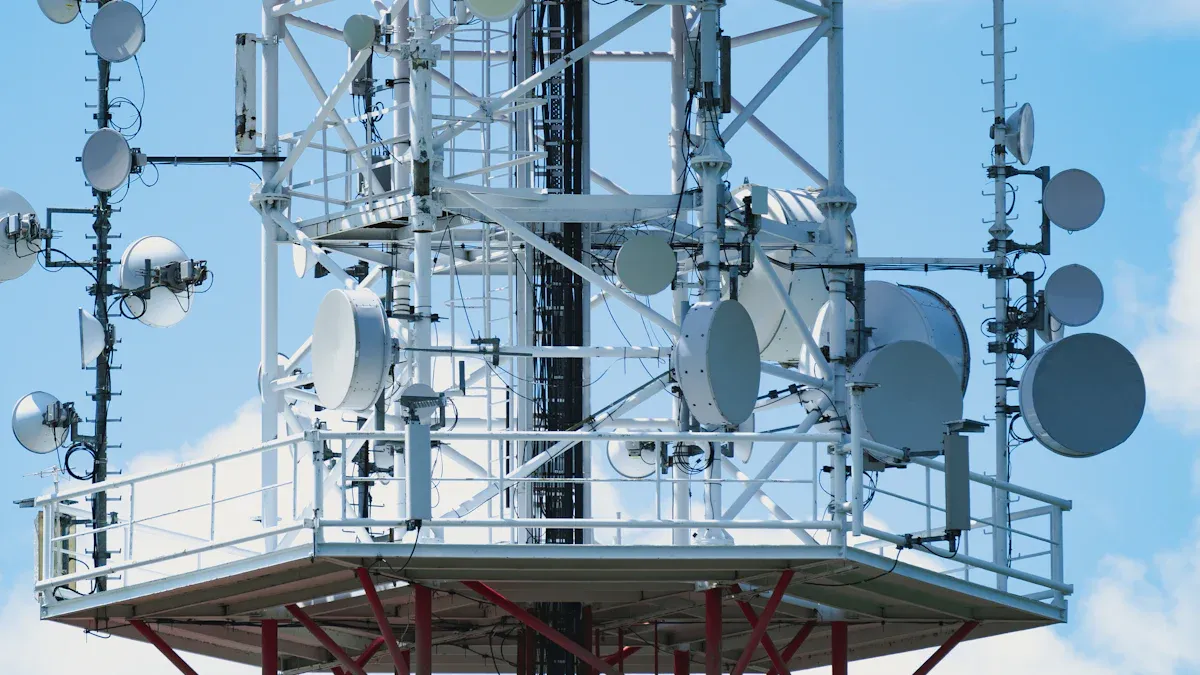Rectifier module efficiency improvements in telecom cabinets based on 10 years of technical accumulation and field validation

Telecom operators have watched rectifier module efficiency go up. It moved from over 95% to almost 97% in ten years. New semiconductor materials and AI-driven systems help a lot. They save up to 30% energy and cut costs by up to 35%. The chart below shows these big changes. It also shows global use and more modular designs.
Trend Aspect | Statistical Evidence | Description/Impact |
|---|---|---|
Efficiency Improvement | From above 95% to ~97% | This lowers energy loss and saves money. |
Operational Cost Reduction | 20-35% decrease | Better efficiency and hybrid power make this happen. |
Energy Consumption Reduction | Up to 30% savings | Advanced materials and smart changes help save energy. |
Deployment Scale | Over 2.4 million installed | Many use this technology and trust it works well. |
Key Takeaways
New rectifier modules in telecom cabinets work better now. Their efficiency went from over 95% to almost 97%. This saves up to 30% energy and lowers costs by 35%.
Modern designs use switchmode technology and advanced semiconductors. They also use smart controls. These help reduce energy loss, heat, and downtime. The modules also fit better in cabinets.
Regular maintenance is important. This includes cleaning and firmware updates every 3 to 6 months. These steps help keep rectifier modules reliable. They also make them last longer.
Modular and scalable rectifier designs help telecom networks grow easily. They do not need long downtime. This supports flexible upgrades and better power management.
Advanced monitoring and cooling systems stop overheating and failures. This makes the system more reliable. It helps telecom operators meet environmental and cost-saving goals.
Efficiency Challenges
Legacy Issues
Telecom cabinets have had many problems with rectifier module efficiency. Older rectifiers were made for less power and simple gear. These old systems do not have modularity, so upgrades are hard and cost a lot. They cannot scale well, so it is tough to add more power. Backup power in old setups is not always reliable during blackouts. Cooling in these cabinets often does not stop overheating as things get older. Low IP ratings let water get in and cause rust. Bad airflow in indoor cabinets makes them too hot and hurts important parts. Cabinets made for old tech cannot handle new loads or smart monitoring.
Old rectifiers made for less power and simple gear
No modularity makes upgrades hard and costly
Poor scaling makes adding power tough
Weak backup power lowers trust
Low IP ratings let water in and cause rust
Bad airflow cuts equipment life
Old cabinets cannot handle new loads or monitoring
Impact on Telecom Cabinets
Old problems still affect how telecom cabinets work now. Many cabinets cannot keep up with what modern networks need. Operators see more energy loss and higher costs. Overheating happens a lot and causes more repairs and downtime. Water and rust hurt electronics, so they must be replaced early. Poor scaling means it is hard to add new tech or more power. When backup power and cooling fail, trust drops. These problems slow down upgrades and make it hard to please customers. Fixing these issues is needed to make telecom cabinets work better and save more energy.
Rectifier Module Advances

Switchmode Technology
Switchmode technology has changed how rectifier modules work. Engineers used switch mode power supplies instead of old silicon-controlled rectifiers. This made efficiency go up from 85–90% to 92–96%. Silicon carbide and gallium nitride semiconductors help push efficiency close to 98%. Switchmode designs use high-frequency operation to lower switching losses and heat. The modules are small and light, so they fit in telecom racks. Rugged packaging and wide temperature tolerance make them work well in tough places. Digital control lets operators set voltage exactly and check problems from far away. These changes help telecom operators save energy, spend less money, and keep power steady for important systems.
Improvement Aspect | |
|---|---|
Efficiency | Higher efficiency (92–96%) than SCR rectifiers (85–90%), so less energy is lost and costs go down. |
Forward Voltage Drop | Very low forward voltage drop means less conduction loss, which helps efficiency in high-current telecom power supplies. |
Switching Losses | Very low switching losses because of high-frequency operation, so less heat is made. |
Better thermal management with good heat sinks and low resistance packages, so cooling needs are less. | |
Size and Weight | Smaller and lighter designs make it easier to put modules in telecom cabinets, saving space and making them more reliable. |
Reliability and Robustness | Rugged packaging, high surge current ability, and wide temperature range make modules more reliable. |
Digital Control Integration | Exact voltage and current control, smart dead-time management, real-time checks, and remote problem solving help performance and cut downtime. |
Advanced Diode Modules | Dual Schottky diode modules with low forward voltage and high surge current make high-current rectification work well. |
Power Factor Correction
Power factor correction helps rectifier modules work better. Bridgeless PFC designs remove the diode bridge, so conduction losses go down. Modern telecom rectifiers use active PFC to make the power factor go from 0.5 to between 0.95 and 0.99. This means less energy and heat are wasted. Advanced topologies like resonant switching converters help use energy better. Telecom operators say system efficiency can reach 97.3% at full load. Projects like GreenConnect show 30% less energy use and 40% less CO2 after using high-efficiency rectifiers with advanced PFC. These changes help keep DC power steady and meet environmental goals.
Tip: High power factor means less wasted energy and lower electricity bills for telecom operators.
Thermal Management
Thermal management keeps rectifier modules working well in telecom cabinets. Advanced cooling systems stop overheating, even when loads are heavy or temperatures are extreme. Rugged construction stands up to dust, humidity, and outdoor weather. IP65-rated enclosures keep out dust and water, and ISO 9227 standards protect against salt corrosion. Good thermal management keeps efficiency above 95%, and some systems reach 97.83%. Cooling systems stop failures from overheating, so repair and replacement costs go down. Small and modular designs save space but still give strong power. Real-time monitoring finds problems early and helps keep things running smoothly.
Aspect | Evidence Summary |
|---|---|
Advanced Cooling Systems | Stop overheating and keep things stable when loads are heavy or temperatures are extreme. |
Rugged Construction | Stands up to dust, humidity, temperature changes, and tough outdoor places. |
Compliance with Standards | IP65 enclosures keep out dust and water; ISO 9227 stops salt corrosion. |
Efficiency Improvements | Keeps efficiency high (above 95%, up to 97.83%), so less energy is lost. |
Fault Tolerance and Durability | Cooling systems stop failures from overheating, so repairs and replacements happen less often. |
Compact and Modular Design | Saves space without losing power or performance. |
Smart Features and Monitoring | Real-time checks help use power better and find problems early, so reliability goes up. |
Control Algorithms
Advanced control algorithms help rectifier modules work better in telecom cabinets. Smart power management lets extra modules go into standby mode, so energy use goes down but backup stays strong. Engineers use MOSFET-based controllers instead of old ORing diodes, which makes modules more efficient and reliable. Digital control changes output waveforms to match what telecom loads need. These changes lower harmonic distortion and save energy. Harmonic compensation cuts losses in inductive parts, so reliability and efficiency go up. Predictive maintenance and real-time checks help operators find faults early and stop downtime. These ideas help keep service going and make upgrades easier.
Smart power management shares loads and saves energy.
MOSFET-based controllers replace old parts and make modules more reliable.
Digital control changes output to match telecom needs.
Harmonic compensation saves energy and makes systems last longer.
Predictive maintenance and real-time checks cut downtime and repair costs.
Rectifier modules now meet strict energy rules and fit telecom cabinet needs. Over 34% of new units have digital control for steady voltage and predictive maintenance. More than 45% of new models are small, fanless, and modular. Companies match their research with clean energy plans, using new materials and smart tech to make modules better. Modular designs and standard sizes make it easy to add more modules or swap them out, which helps telecom operators stay flexible and keep services running. These advances help meet rules and keep telecom networks working in many places.
Field Validation

Testing Methods
Telecom engineers use many ways to test rectifier module efficiency. They measure power going in and out to see how well modules work. They check temperatures inside cabinets to make sure cooling works. Engineers run tests during busy times and bad weather to see if modules stay strong. EMI tests help find problems from switching noise or bad PCB design. Maintenance teams look for dust, blocked airflow, and loose wires. They test firmware updates to make sure they work well. Teams also check fans and vents to stop overheating.
Testing Method | Purpose | Common Obstacles |
|---|---|---|
Power Measurement | See how efficient modules are at different loads | EMI and dust can cause trouble |
Thermal Monitoring | Watch temperature and cooling | Airflow blocks and old thermal paste |
Stress Testing | Test reliability in tough conditions | Overheating and broken cables |
EMI Testing | Find interference and stability problems | Bad PCB and switching noise |
Maintenance Inspection | Make sure wires and airflow are good | Loose wires and dust |
Firmware Update Validation | Check if software is safe and works well | Update problems and software issues |
Note: Doing regular checks and careful firmware updates helps stop downtime and keeps telecom equipment safe.
Case Studies
Real-life stories show how better rectifier modules help telecom work.
Outdoor base stations in far places use small, strong modules with good cooling. These stations keep working during heat and storms.
AI data centers use smart control to change power when workloads jump. Controllers balance modules and energy storage, so equipment does not get stressed.
Pre-charging energy storage helps smooth big changes in power and protects telecom gear from surges.
Modular designs let operators add more power without stopping work. This helps networks grow easily.
Better cooling makes equipment last longer and work more, so costs go down.
Using renewable energy with advanced DC rectifiers helps meet green goals and stops outages.
Tip: Using modular rectifier modules lets telecom operators grow networks fast and keep them reliable.
Operator Feedback
Telecom operators say new rectifier modules work very well.
Operators like that modules use about 20% less energy, so costs go down.
Customers get smooth service with hybrid power, even during outages.
Modules work well in tough places, like remote or off-grid spots, because they are strong and protected.
Smart monitoring and modular designs help operators work better and have less downtime.
People say energy savings and reliability are great, and telecom work gets better.
Modules meet world reliability rules and have safety features like voltage and temperature checks.
High efficiency means less energy is lost and less heat is made, so equipment lasts longer.
Good customer support and custom options help modules work their best and keep downtime low.
Operators like saving energy, having reliable modules, and getting strong support when picking rectifier modules for telecom cabinets.
Results and Benefits
Energy Savings
Telecom operators save more energy with new rectifier modules. These modules help networks use less power and cost less money. The table below shows how better efficiency helps different things:
Metric | Quantifiable Result |
|---|---|
End-to-end power efficiency improvement | Up to 5% increase compared to 54 V systems |
Maintenance cost reduction | Up to 70% decrease due to fewer PSU failures |
Cooling expenses | Reduced by eliminating AC/DC PSUs in racks |
Power transmission capacity | 85% more power through same conductor size |
Copper usage | Reduced by 45% due to lower current demand |
Total Cost of Ownership (TCO) | Reduced by up to 30% through efficiency gains |
Operators pay less for electricity and cooling equipment. These savings let telecom companies buy better services and new technology.
Reliability
Rectifier module efficiency makes telecom cabinets work better. High-efficiency modules reach up to 98% and make less heat. Less heat helps equipment last longer and work well. Advanced cooling, like energy-saving fans and outdoor systems, keeps things cool. These features stop overheating and make control easier. Operators see fewer failures and less downtime. Better reliability lowers costs and keeps networks working.
Note: Reliable power systems help telecom networks stay online during storms and busy times.
Environmental Impact
Efficiency improvements in rectifier modules help the environment in many ways:
High-efficiency modules with advanced materials like SiC and GaN cut energy loss and heat.
Less heat means less air conditioning, so energy use goes down.
Equipment lasts longer, so fewer parts go to landfills.
Modular designs make upgrades easy and cut waste from old systems.
Advanced monitoring tools help operators fix problems early and stop big failures.
Certified modules with the right size make systems work better and cost less over time.
Power loss drops by up to 75% compared to older models, so electricity use and carbon emissions go down.
Operators add extra capacity for future growth, and efficient converters help manage this without wasting energy.
Mean Time Between Failure (MTBF) for telecom rectifier modules is between 100,000 and 200,000 hours, so total cost of ownership stays low.
These benefits help telecom companies reach green goals and support a cleaner future.
Best Practices
Maintenance
Doing regular maintenance helps rectifier modules work well and last longer in telecom cabinets. Operators use a step-by-step plan to stop failures and make equipment last.
Clean rectifier modules every 3 to 6 months. This stops dust from building up and keeps things from getting too hot.
Use the right tools to check voltage and current levels. This helps find problems early.
Look at electrical connections often and tighten them. Change old parts like capacitors and diodes every year.
Update firmware and software every few months. This makes things safer and work better.
Keep dust, heat, and moisture low with cooling and dehumidifiers.
Use sensors and analytics to watch temperature and voltage. This helps find faults early.
Pick good replacement parts from brands you trust.
Teach staff with lessons and hands-on practice. This helps stop long downtime.
Sticking to a regular maintenance plan helps operators find problems early. This saves money on repairs and keeps networks working well.
Scalability
Telecom operators need solutions that can grow as networks get bigger. There are many ways to help cabinets handle more power and different sizes.
Modular designs let you add or swap rectifier modules easily. This helps meet new power needs.
Air cooling is good for small and medium cabinets. Liquid cooling works better for big or tough places.
Using silicon carbide and gallium nitride makes modules smaller and more powerful.
Synchronous rectification and low-loss MOSFETs waste less energy and need less cooling.
Smart monitoring lets operators track things in real time and manage from far away.
Operators pick rectifier types like half-wave, full-wave, or bridge for each cabinet.
Self-checking and fault tolerance make fixing and growing easier.
These steps help make sure power stays steady and efficient for any cabinet size.
Monitoring Systems
Watching rectifier modules all the time is important for keeping them efficient. Modern telecom cabinets use environment monitoring systems with sensors for smoke, water, temperature, and doors. These systems use protocols like RS232, RS485, SNMP, and TCP/IP. This lets them work with network management tools. Advanced monitors show voltage, current, and frequency on screens. Alarms with sounds and lights warn operators about problems so they can act fast. Data analytics tools, like NetFinity Management System, mix device and energy checks for real-time fixes and early maintenance. Good monitoring and quick help from makers help operators keep things efficient and avoid costly downtime.
Telecom operators have made big improvements in rectifier module efficiency. They use modular designs, better control systems, and real-time monitoring. These changes help save energy, cut costs, and make things more reliable. New technology keeps making systems smarter and smaller. In the future, the industry will use high-density power units and AI for maintenance. Wide bandgap semiconductors will also be used. These trends will help telecom cabinets handle bigger networks and work in a greener way.
FAQ
What is the main benefit of high-efficiency rectifier modules in telecom cabinets?
High-efficiency rectifier modules help save energy and money. They also make systems more reliable. These modules support green goals too.
How often should operators perform maintenance on rectifier modules?
Operators need to clean and check rectifier modules every 3 to 6 months. Doing regular checks stops overheating and helps equipment last longer.
Tip: Sensors that watch in real time help operators find problems fast.
Can modular rectifier designs support network growth?
Yes. Modular designs let operators add or swap modules easily. This makes it simple for networks to grow without long downtime.
Feature | Benefit |
|---|---|
Modular Design | Easy to upgrade |
Scalability | Helps networks grow |
What standards do advanced rectifier modules meet?
Advanced rectifier modules meet IP65 for dust and water safety. They also follow ISO 9227 for rust protection and world energy rules.
See Also
Steps To Guarantee Consistent Power In Telecom Cabinets
Solar Inverter And Battery Setup Linked To Grid For Telecom
Methods To Calculate Power And Battery Needs For Telecom Cabinets
Solar Energy Storage Solutions Designed For Telecom Cabinets
Reasons Lithium Batteries Are Superior For Telecom Cabinet Use
CALL US DIRECTLY
86-13752765943
3A-8, SHUIWAN 1979 SQUARE (PHASE II), NO.111, TAIZI ROAD,SHUIWAN COMMUNITY, ZHAOSHANG STREET, NANSHAN DISTRICT, SHENZHEN, GUANGDONG, CHINA

